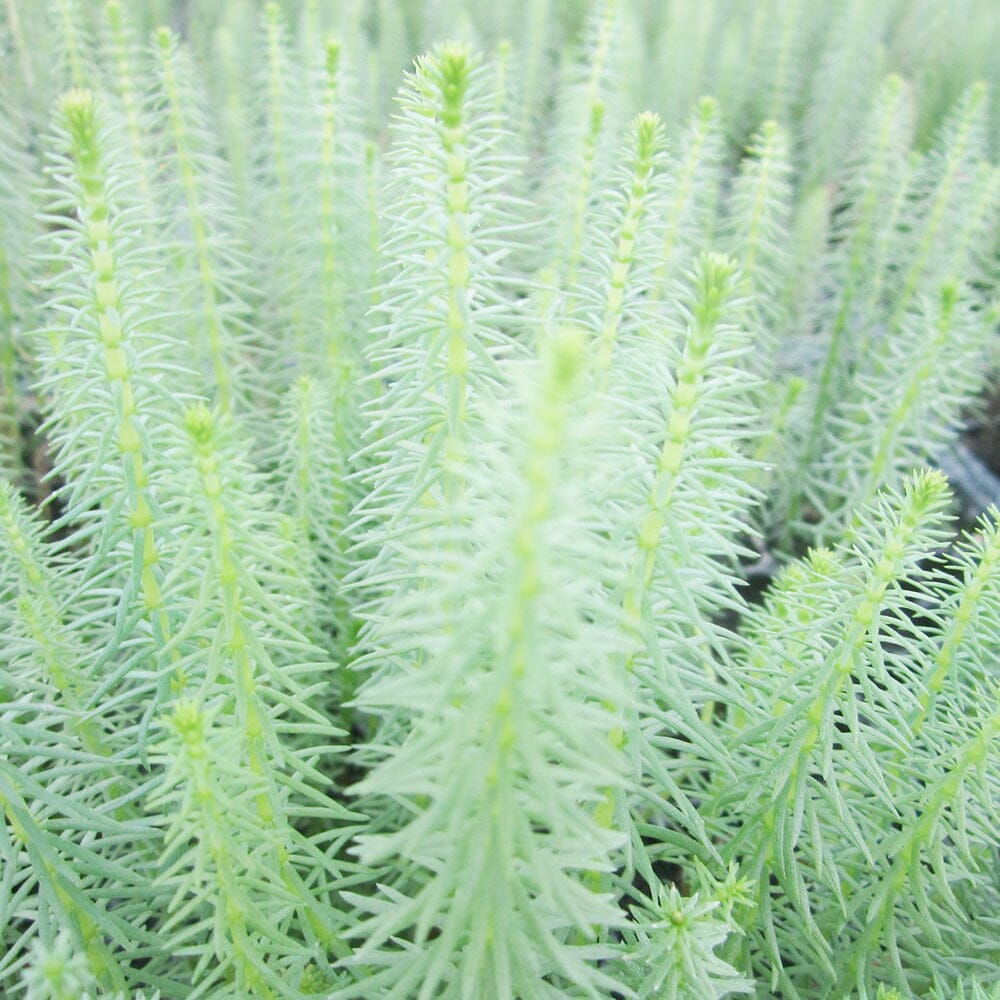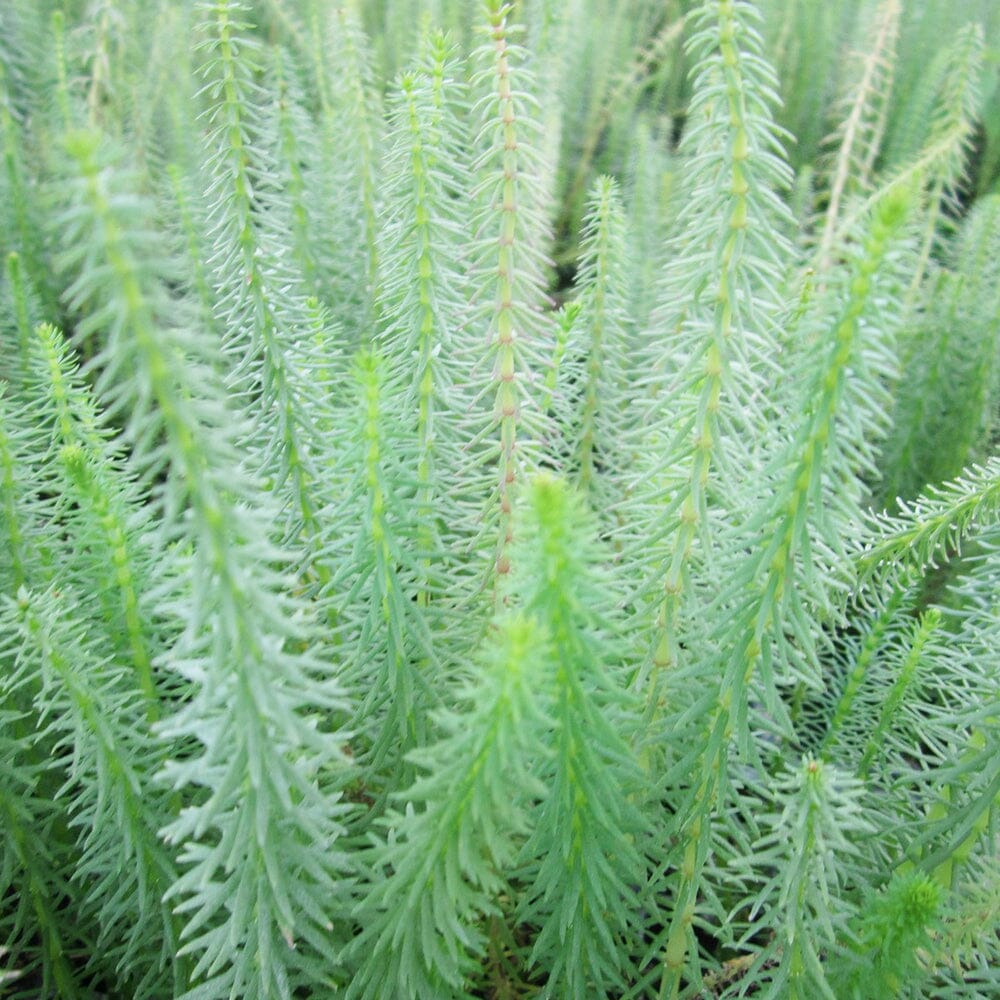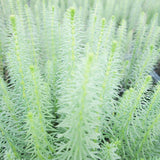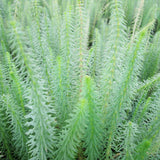Hippuris Vulgaris Aquatic Pond Plant - Mare's Tail
Hippuris vulgaris, commonly known as Mare's Tail or Common Mare's Tail, is a perennial aquatic plant that belongs to the family Plantaginaceae. It is native to Eurasia and North America and is commonly found in freshwater ponds, lakes, streams, and wetlands. Here is a detailed description and care guide for Hippuris vulgaris:
Description:
Hippuris vulgaris has a unique appearance, resembling a horse's tail, hence its common name. It features long, slender, unbranched stems that can grow up to 100 cm (39 inches) in height. The stems are densely covered with tiny, narrow, opposite leaves, giving them a distinctive whorled appearance. The leaves are typically light green, linear to lanceolate in shape, and measure around 1-3 cm (0.4-1.2 inches) in length. The plant does not produce true flowers but instead has inconspicuous, small, greenish-white inflorescences at the tips of the stems.
Care Guide:
Water Requirements: Hippuris vulgaris is an aquatic plant that requires a stable water environment. It thrives in full sun to partial shade and prefers calm, still water. Ensure that the water level remains consistent, covering the stems and leaves but avoiding excessive submergence.
Lighting: Provide bright to moderate lighting conditions for Hippuris vulgaris. If growing indoors, use full spectrum grow lights or place the plant near a window with filtered sunlight.
Water Quality: Maintain good water quality by ensuring the water is clean, free from pollutants, and has good oxygenation. Regularly monitor and adjust water parameters such as pH, temperature, and nutrient levels to promote healthy growth.
Substrate: Hippuris vulgaris prefers a sandy or silty substrate in which it can anchor its roots. If growing in a pond or water feature, ensure the substrate is rich in organic matter.
Fertilization: Supplement the growth of Hippuris vulgaris with a balanced aquatic plant fertilizer or slow-release aquatic plant pellets. Follow the recommended dosage instructions, as excessive fertilization can lead to algae growth or water quality issues.
Pruning and Maintenance: Trim any dead or decaying leaves or stems to maintain the plant's appearance and prevent overcrowding. Regularly remove any fallen leaves or debris from the water to prevent water contamination.
Propagation: Hippuris vulgaris can propagate through stem fragments. When pruning or thinning the plant, the cuttings can be replanted in the substrate or allowed to float in the water until they develop roots.
Pests and Diseases: Hippuris vulgaris is generally resistant to pests and diseases. However, it may occasionally be susceptible to algae growth if the water conditions are not properly maintained. Monitor the plant regularly and address any algae issues promptly through water quality adjustments or the use of algae-controlling treatments. Hippuris vulgaris is a visually appealing aquatic plant that adds a touch of elegance and natural beauty to water gardens, ponds, and aquatic landscapes. It provides habitat and shelter for aquatic organisms and can help to improve water quality by absorbing excess nutrients. However, it is important to prevent the spread of Hippuris vulgaris into natural water bodies, as it can become invasive and outcompete native plant species. Always check and comply with local regulations regarding the cultivation and control of Hippuris vulgaris in your region.
Selection of Plants:
Choose appropriate oxygenating plants that are suitable for the size and depth of your pond. Common oxygenating plants include Hornwort (Ceratophyllum), Anacharis (Elodea canadensis), Waterweed (Elodea densa), and Watermilfoil (Myriophyllum species).
Placement:
Place oxygenating plants in the water at a depth where their foliage is fully submerged. Distribute the plants evenly throughout the pond, ensuring they receive adequate sunlight for photosynthesis.
Water Quality:
Oxygenating plants play a crucial role in maintaining good water quality by absorbing excess nutrients, competing with algae for resources, and releasing oxygen through photosynthesis. Regularly monitor water quality parameters such as pH, ammonia, nitrite, and nitrate levels to ensure they are within suitable ranges for the plants.
Nutrient Levels:
Oxygenating plants benefit from moderate nutrient levels in the water, but excessive nutrients can lead to rapid algae growth. Avoid over-fertilization or excessive organic matter accumulation in the pond, as it can negatively impact oxygenating plants.
Pruning and Maintenance:
Regularly thin out and prune oxygenating plants to prevent overcrowding and ensure healthy growth. Remove any dead or decaying plant material promptly to maintain water quality and prevent the release of excess nutrients.
Winter Care:
Some oxygenating plants may need special attention during winter, especially in colder climates. If your pond experiences freezing temperatures, consider moving potted plants indoors or provide insulation to protect them. In milder climates, oxygenating plants may continue to grow during winter, providing oxygen and supporting the pond ecosystem.
Propagation:
Some oxygenating plants can be propagated by dividing or taking cuttings. Follow specific instructions for each plant species to propagate them successfully and maintain a healthy population in your pond.
Monitoring and Control:
Regularly observe the growth and condition of oxygenating plants to identify any signs of disease, pests, or nutrient deficiencies. If needed, control excessive growth by removing excess plant material, but be careful not to remove too much at once, as it can disturb the pond's ecological balance.
Introduction of New Plants:
Before introducing new oxygenating plants into your pond, ensure they are free from pests, diseases, or invasive species. Avoid introducing non-native species that may become invasive and harm the local ecosystem. By following these general tips and care guidelines, you can maintain healthy oxygenating plants in your pond. They will contribute to the overall oxygenation of the water, provide habitat for beneficial organisms, and promote a thriving pond ecosystem.
































